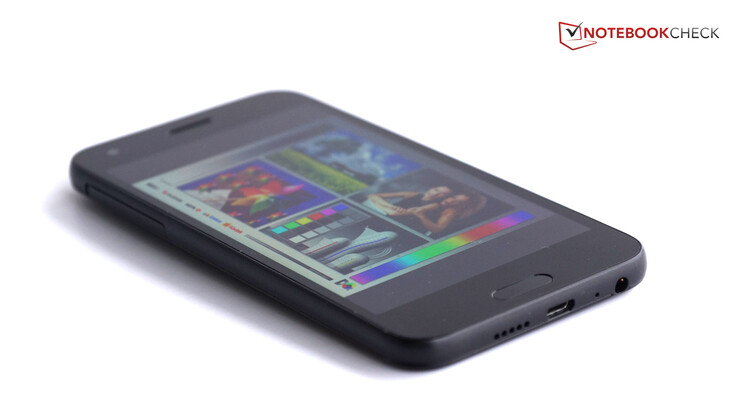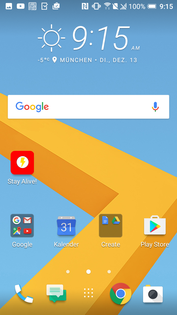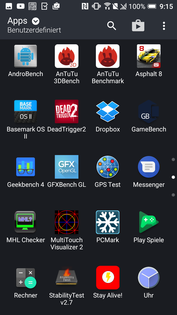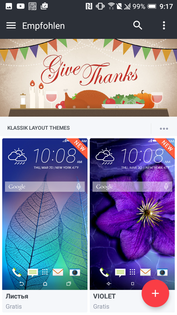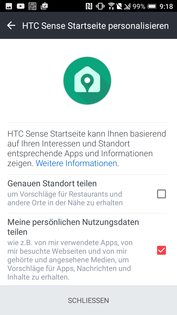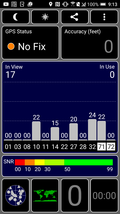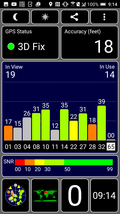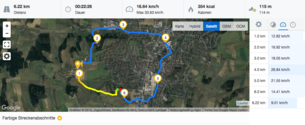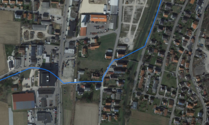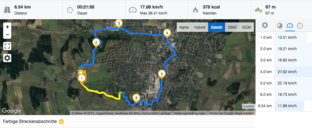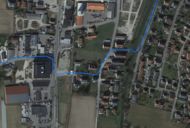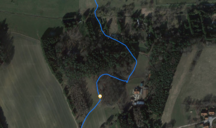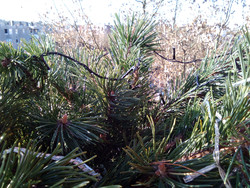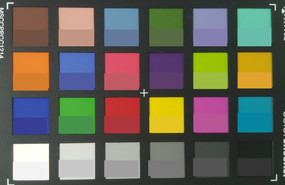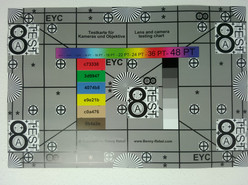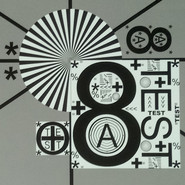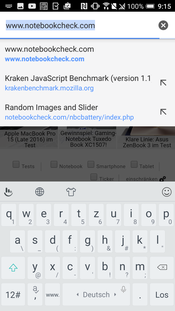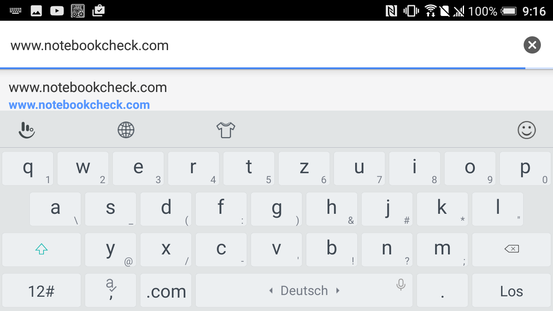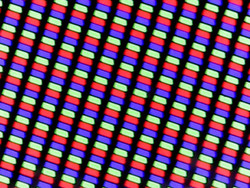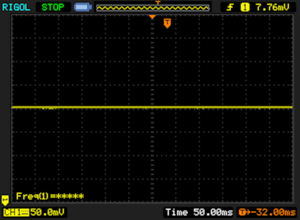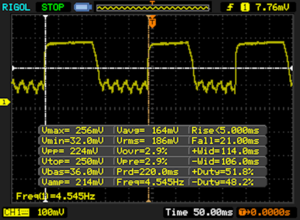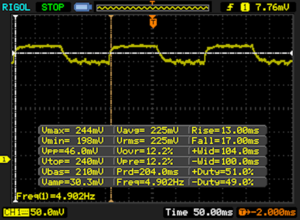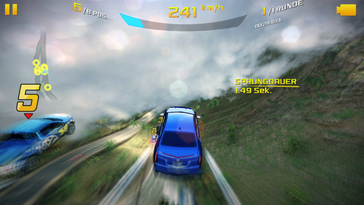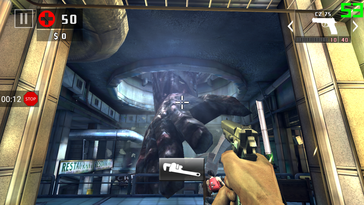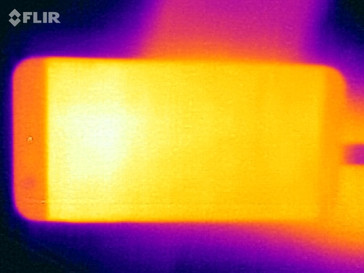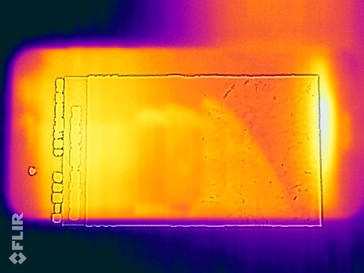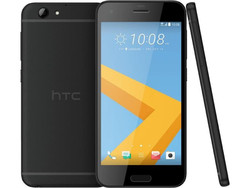HTC One A9s Smartphone Review
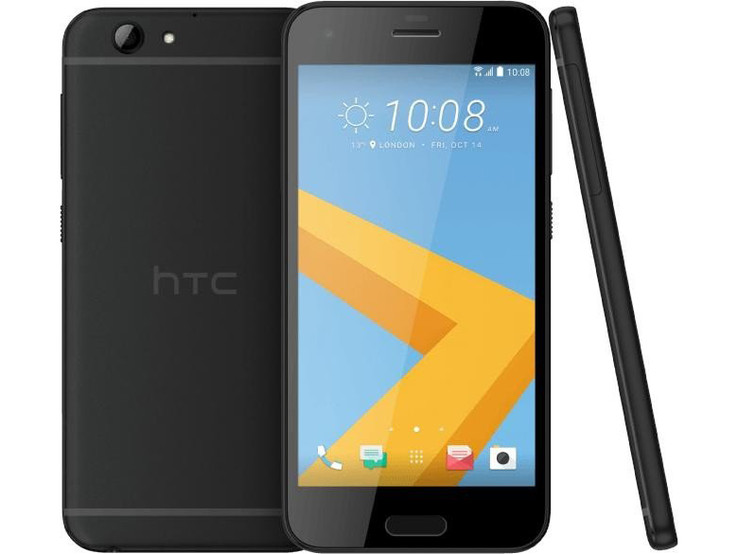
For the original German review, see here.
HTC sold the previous HTC One A9 for 599 Euros (~$626). The performance was too low for the high-end price, but we liked the chassis as well as the screen. The HTC One A9s has a better market position in the mainstream segment for 299 Euros (~$313). However, there are numerous strong competitors in this price range by now.
The slightly older OnePlus 2 with numerous high-end features is not much more expensive. Another price breaker is the Lenovo ZUK Z2. Samsung's Galaxy A5 is also a very decent mainstream device, the Gigaset ME an impressive newcomer. We will obviously compare the new model with the previous HTC One A9 to see the impact of the big price difference (300 Euros/~$314).
Case
The chassis of the HTC One A9 was very similar to Apple's current iPhones. This is also the case for the One A9s, although we can find some small changes: Our dark gray test model now has a matte finish on the rear, whereas the old model had a brushed metal look. Other available colors are silver and gold, so HTC follows the current mainstream and does not experiment.
The front of the smartphone is completely covered by glass. The small oval fingerprint scanner is sitting pretty far underneath the screen. Similar to the predecessor, there would have been more space for the actual screen. At a length of 146 mm (~5.7 in), the One A9s is a somewhat long smartphone. Otherwise, it is a bit wider than before and much thicker at 8 mm (~0.3 in). The weight was also increased to 150 grams (~5.3 oz).
The chassis is stable and we can hardly twist it, but our attempts cause loud creaking sounds. Pressure on the screen will quickly result in ripples, but pressure from behind is no problem. The battery is integrated and you cannot open the chassis.
Connectivity
The price of the HTC One A9 has dropped to the level of the One A9s by now, but the connectivity of the new mainstream smartphone was actually improved at some points, despite the lower starting price: We now get 3 GB RAM and 32 GB internal storage, for example, which also beats some of the comparison devices. Lenovo's ZUK Z2 and the OnePlus 2 on the other hand are even better equipped in terms of memory with 4 GB / 64 GB.
USB-OTG is supported by the HTC One A9s, so you can attach external storage devices. You also get a microSD reader, which means the storage capacity can be expanded by up to 2 TB, even though cards with such capacities are not available yet. It is possible to format the card as internal storage, but it is not possible to transfer apps to the microSD when you only use the card as portable storage.
Software
HTC ships the One A9s with Android 6.0 and security patches from September 5th, so it is not the latest version. The smartphone could be upgraded to Android 7, but there is currently no timeframe from HTC.
The manufacturer always used customized software versions and tried to improve Android at many points. This is basically a good idea, but it also introduces problems, because the internal functions will not get any updates once the system updates will be stopped. HTC tries to avoid this problem with the implementation of its own apps for a couple of years now, so individual parts are easier to update. However, this also means that some app functionalities are similar to the preloaded Google apps, like HTC's Mail app and "GMail" or "Messages" and the Android messenger.
Also available is the iconic BlinkFeed, which can be accessed with a swipe to the right on the home screen. It shows news and notifications from social media. "Boost+" can be used to clean and accelerate the system. The "Zoe Video Editor" is also a typical app from HTC, which creates movies with several effects from pictures and videos.
You can also install themes on the smartphone, including so called "Freestyle Theme", where you can freely adjust app symbols and stickers on the screen without a predefined grid.
Communication and GPS
You will have to make compromises in terms of WLAN connectivity: While the HTC One A9 still supported fast 802.11ac networks, the HTC One A9s is limited to 802.11n. This should be sufficient for most Internet connections, but the smartphone cannot use very fast home networks. 5 GHz networks are still supported though.
The WLAN performance is decent in our standardized test, and we determine the expected values both in the send as well as the receive test. We can see, however, a significant performance difference to devices with 802.11ac.
Websites load quickly in practice in close proximity to the router and we have a full signal. The quality does drop significantly at a distance of ten meters (~33 feet) to 1/4 of the signal and loading times are a bit longer, but there is sometimes no connection at all.
| Networking | |
| iperf3 transmit AX12 | |
| Apple iPhone 7 (Klaus I211) | |
| Samsung Galaxy S7 | |
| HTC One A9s | |
| HTC Desire 10 Lifestyle | |
| iperf3 receive AX12 | |
| Apple iPhone 7 (Klaus I211) | |
| Samsung Galaxy S7 | |
| HTC One A9s | |
| HTC Desire 10 Lifestyle | |
The GPS module cannot locate the position indoors, and it does not work close to a window, either. A connection with the satellites is quickly established outdoors though and the accuracy of six meters (~20 feet) is pretty decent.
Our two track measurements between the HTC One A9s and the professional navigation device Garmin Edge 500 differ by 300 meters (~1.9 miles) on the 7 km (~4.3 miles) bicycle ride. Garmin's Edge 500 follows our position more accurately, but the performance of the HTC One A9s should still be sufficient for casual purposes.
Telephone Functions and Voice Quality
HTC also updated and adjusted the phone app, but the functionality is still very similar to Google's default app.
The voice quality is average: The earpiece is very loud, but the voice from our call partner always sounds a bit dull. The same applies for the microphone: Our voice is a bit dull, but the overall quality of the microphone is still okay. Background noises are audible, but the voice is easy to understand. In general, for calls, there are worse smartphones. The voice output via speaker is also decent.
Cameras
The technical specs of the cameras look very similar to the previously reviewed HTC Desire 10 Lifestyle at first. The front camera was quite okay, but the main camera was not convincing. The situation is better here: If HTC uses the same camera module, the Taiwanese manufacturer did a much better job on the HTC One A9s.
The pictures of the 13 MP main camera with a single LED flash and autofocus show much more details in bright and dark areas. We can see slight color fringes at the edges when we zoom in, but the pictures are very sharp overall and the colors are okay, even though we can see a slight green cast. Videos can be recorded in Full HD at 30 frames per second with the main camera. The quality is good: Transitions between bright and dark areas are handled quickly and colors are accurate as well.
The front camera has a 5 MP sensor and takes decently sharp pictures, which are also well exposed. You can zoom in without seeing bigger blurs. The front camera can also take 1080p videos and the quality is good.
We check the color accuracy of the main camera with a picture of the CalMAN ColorChecker Passport under controlled lighting conditions. Compared to the reference colors, most of the colors are accurate, but bright colors are a bit too dark.
We also take a picture of the test chart under controlled lighting conditions to evaluate the sharpness. One noticeable aspect is that fonts fray on colored areas. The crop from the center is not perfectly sharp either, and we can once again see slightly frayed edges.
Accessories and Warranty
Besides the power adapter and the USB cable, the box of the HTC One A9s also includes a headset, so basically the standard equipment.
HTC will also sell a premium pack of the smartphone on its website for an additional 40 Euros (~$42). The set includes a transparent cover for the rear, a protective display cover and a better headset. It is currently not possible to get these accessories separately.
HTC grants a 24-month warranty for its smartphones. Please see our Guarantees, Return Policies & Warranties FAQ for country-specific information.
Input Devices and Handling
HTC uses the virtual keyboard "TouchPal", which can be adjusted in many ways. You can change the size of the keyboard or split it. Due to the secondary functions, however, it is a bit too crowded compared to the default Android keyboard in our opinion. Of course, you can activate the default keyboard in the settings or download other layouts from the Play Store.
The touchscreen is precise and very responsive in the corners. The fingerprint sensor underneath the screen also works as a home button and there are surrounding touch buttons for the menu functions. At the right side of the case is the ribbed standby button, which is easy to find thanks to its surface. The volume rocker is easy to use as well.
Unlocking the smartphone via fingerprint scanner is easy and simple: Just put your finger on the sensor. Unfortunate: You have to tap the fingerprint scanner twice during standby to unlock it, one tap is sufficient for other smartphones.
Display
Compromises compared to the previous model have to be made in terms of the display as well: At the same size (5 inches), the resolution was reduced to 1280x720 pixels. It is not an AMOLED panel anymore, either, but a conventional IPS screen. This is not necessarily a bad thing, but the average luminance of 320 nits is a bit low. The brightness distribution of 85% is okay, and you can only see slight brightness differences on large colored surfaces.
| |||||||||||||||||||||||||
Brightness Distribution: 85 %
Center on Battery: 348 cd/m²
Contrast: 1513:1 (Black: 0.23 cd/m²)
ΔE Color 3.5 | 0.5-29.43 Ø5
ΔE Greyscale 4 | 0.57-98 Ø5.3
95.1% sRGB (Calman 2D)
Gamma: 2.3
| HTC One A9s IPS, 1280x720, 5.00 | OnePlus 2 IPS, 1920x1080, 5.50 | Lenovo ZUK Z2 IPS, 1920x1080, 5.00 | Gigaset ME IPS, 1920x1080, 5.00 | Samsung Galaxy A5 2016 Super AMOLED, 1920x1080, 5.20 | HTC One A9 AMOLED, 1920x1080, 5.00 | |
|---|---|---|---|---|---|---|
| Screen | 5% | -18% | -10% | 31% | 24% | |
| Brightness middle | 348 | 451 30% | 512 47% | 445 28% | 378 9% | 346 -1% |
| Brightness | 320 | 446 39% | 502 57% | 456 43% | 380 19% | 349 9% |
| Brightness Distribution | 85 | 90 6% | 84 -1% | 93 9% | 91 7% | 93 9% |
| Black Level * | 0.23 | 0.3 -30% | 0.58 -152% | 0.38 -65% | ||
| Contrast | 1513 | 1503 -1% | 883 -42% | 1171 -23% | ||
| Colorchecker dE 2000 * | 3.5 | 3.84 -10% | 3.8 -9% | 4.29 -23% | 1.95 44% | 1.55 56% |
| Colorchecker dE 2000 max. * | 6.4 | 11.2 -75% | 7.89 -23% | 3.09 52% | ||
| Greyscale dE 2000 * | 4 | 3.97 1% | 2.7 32% | 4.97 -24% | 1.86 53% | 2.05 49% |
| Gamma | 2.3 96% | 2.46 89% | 2.09 105% | 2.57 86% | 2.13 103% | 2.15 102% |
| CCT | 6527 100% | 7283 89% | 6076 107% | 7625 85% | 6376 102% | 6267 104% |
| Color Space (Percent of AdobeRGB 1998) | 58.07 | |||||
| Color Space (Percent of sRGB) | 90.14 |
* ... smaller is better
Screen Flickering / PWM (Pulse-Width Modulation)
| Screen flickering / PWM not detected | |||
In comparison: 53 % of all tested devices do not use PWM to dim the display. If PWM was detected, an average of 17900 (minimum: 5 - maximum: 3846000) Hz was measured. | |||
The black value of 0.23 cd/m² on the other hand is very good, which results in a good contrast ratio of 1513:1. However, the AMOLED screens of the HTC One A9 and the Samsung Galaxy A5 have completely black pixels and therefore an infinite contrast ratio.
We use the software CalMAN and a spectrophotometer for further analysis of the colors. The deviations compared to the reference color space sRGB are small, but the predecessor managed even better results. Still, you can hardly see differences on the HTC One A9s with the naked eye. The grayscale only reveals a slight green cast, otherwise, the individual shades are very accurate.
Display Response Times
| ↔ Response Time Black to White | ||
|---|---|---|
| 26 ms ... rise ↗ and fall ↘ combined | ↗ 5 ms rise | |
| ↘ 21 ms fall | ||
| The screen shows relatively slow response rates in our tests and may be too slow for gamers. In comparison, all tested devices range from 0.1 (minimum) to 240 (maximum) ms. » 57 % of all devices are better. This means that the measured response time is worse than the average of all tested devices (21.5 ms). | ||
| ↔ Response Time 50% Grey to 80% Grey | ||
| 30 ms ... rise ↗ and fall ↘ combined | ↗ 13 ms rise | |
| ↘ 17 ms fall | ||
| The screen shows slow response rates in our tests and will be unsatisfactory for gamers. In comparison, all tested devices range from 0.2 (minimum) to 636 (maximum) ms. » 34 % of all devices are better. This means that the measured response time is better than the average of all tested devices (33.7 ms). | ||
The low luminance of the HTC One A9s is a problem outdoors because you can hardly see anything on the screen in bright environments. The brightness sensor tries hard and reacts quickly, but it cannot further increase the luminance of the panel.
The viewing angles are good, but the brightness drops significantly when you change the vertical viewing position. Still, you can see the display contents very well even from extreme angles.
Performance
The Mediatek Helio P10 MT6755 is an upper mainstream SoC with eight cores, and all of them can reach a clock of 2.0 GHz. It supports the 64-bit architecture. Still, the performance of the HTC One A9s cannot keep up with the best devices: Smartphones with high-end SoCs from Qualcomm's 810 and 820 series in particular have an advantage.
The performance is still more than sufficient for the operating system in practice and ensures smooth handling. You will only notice differences when you use demanding apps.
The graphics unit is the ARM Mali-T860 MP2, and it can actually beat the Qualcomm Adreno 405 from the predecessor by a couple of frames in some tests. However, we obviously have to consider the lower display resolution in the onscreen benchmarks. Once again there are competitors with better performance in this price range.
| AnTuTu v6 - Total Score (sort by value) | |
| HTC One A9s | |
| OnePlus 2 | |
| Lenovo ZUK Z2 | |
| Gigaset ME | |
| Samsung Galaxy A5 2016 | |
| Geekbench 4.0 | |
| 64 Bit Single-Core Score (sort by value) | |
| HTC One A9s | |
| 64 Bit Multi-Core Score (sort by value) | |
| HTC One A9s | |
| GFXBench (DX / GLBenchmark) 2.7 | |
| T-Rex Onscreen (sort by value) | |
| HTC One A9s | |
| OnePlus 2 | |
| Lenovo ZUK Z2 | |
| Gigaset ME | |
| Samsung Galaxy A5 2016 | |
| HTC One A9 | |
| 1920x1080 T-Rex Offscreen (sort by value) | |
| HTC One A9s | |
| OnePlus 2 | |
| Lenovo ZUK Z2 | |
| Gigaset ME | |
| Samsung Galaxy A5 2016 | |
| HTC One A9 | |
| GFXBench 3.0 | |
| on screen Manhattan Onscreen OGL (sort by value) | |
| HTC One A9s | |
| OnePlus 2 | |
| Lenovo ZUK Z2 | |
| Gigaset ME | |
| Samsung Galaxy A5 2016 | |
| HTC One A9 | |
| 1920x1080 1080p Manhattan Offscreen (sort by value) | |
| HTC One A9s | |
| OnePlus 2 | |
| Lenovo ZUK Z2 | |
| Gigaset ME | |
| Samsung Galaxy A5 2016 | |
| HTC One A9 | |
| GFXBench 3.1 | |
| on screen Manhattan ES 3.1 Onscreen (sort by value) | |
| HTC One A9s | |
| OnePlus 2 | |
| Lenovo ZUK Z2 | |
| Gigaset ME | |
| HTC One A9 | |
| 1920x1080 Manhattan ES 3.1 Offscreen (sort by value) | |
| HTC One A9s | |
| OnePlus 2 | |
| Lenovo ZUK Z2 | |
| Gigaset ME | |
| HTC One A9 | |
| PCMark for Android - Work performance score (sort by value) | |
| HTC One A9s | |
| OnePlus 2 | |
| Lenovo ZUK Z2 | |
| Gigaset ME | |
| Samsung Galaxy A5 2016 | |
| HTC One A9 | |
Our browser benchmarks determine average results for the HTC One A9s when they use modern technologies like HTML5 or JavaScript. It is at least a bit faster than the previous model in most tests. Subjectively, the browsing experience is pretty good. Websites are loaded quickly and the animations we tested ran smoothly.
| Octane V2 - Total Score (sort by value) | |
| HTC One A9s | |
| OnePlus 2 | |
| Lenovo ZUK Z2 | |
| Gigaset ME | |
| Samsung Galaxy A5 2016 | |
| HTC One A9 | |
| Mozilla Kraken 1.1 - Total (sort by value) | |
| HTC One A9s | |
| OnePlus 2 | |
| Lenovo ZUK Z2 | |
| Gigaset ME | |
| Samsung Galaxy A5 2016 | |
| HTC One A9 | |
| WebXPRT 2015 - Overall (sort by value) | |
| HTC One A9s | |
| OnePlus 2 | |
| Samsung Galaxy A5 2016 | |
| HTC One A9 | |
| JetStream 1.1 - Total Score (sort by value) | |
| HTC One A9s | |
| OnePlus 2 | |
| Lenovo ZUK Z2 | |
| Gigaset ME | |
| Samsung Galaxy A5 2016 | |
| HTC One A9 | |
* ... smaller is better
We evaluate the performance of the microSD reader with our reference card, a fast Toshiba Exceria Pro M401. The HTC One A9s cannot utilize the possible performance and only manages mediocre results.
The situation is similar for the internal storage, but we can see a positive outlier for the random write results, where the HTC One A9s can take the top spot. The writing performance is generally better than the reading performance. The loading times of apps are rather long.
| AndroBench 3-5 | |
| Sequential Read 256KB (sort by value) | |
| HTC One A9s | |
| OnePlus 2 | |
| Lenovo ZUK Z2 | |
| Gigaset ME | |
| Samsung Galaxy A5 2016 | |
| HTC One A9 | |
| Sequential Write 256KB (sort by value) | |
| HTC One A9s | |
| OnePlus 2 | |
| Lenovo ZUK Z2 | |
| Gigaset ME | |
| Samsung Galaxy A5 2016 | |
| HTC One A9 | |
| Random Read 4KB (sort by value) | |
| HTC One A9s | |
| OnePlus 2 | |
| Lenovo ZUK Z2 | |
| Gigaset ME | |
| Samsung Galaxy A5 2016 | |
| HTC One A9 | |
| Random Write 4KB (sort by value) | |
| HTC One A9s | |
| OnePlus 2 | |
| Lenovo ZUK Z2 | |
| Gigaset ME | |
| Samsung Galaxy A5 2016 | |
| HTC One A9 | |
| Sequential Read 256KB SDCard (sort by value) | |
| HTC One A9s | |
| Sequential Write 256KB SDCard (sort by value) | |
| HTC One A9s | |
Games
The SoC and its graphics adapter support modern interfaces like OpenGL ES 3.1, so you can also enjoy modern effects. The smartphone has no problems with the zombie shooter Dead Trigger 2, where the smartphone breaks the 30 fps barrier and reaches 58 frames per second on average. The racing title Asphalt 8: Airborne also runs well on the test model, even though 30 fps are just missed at maximum details.
We did not have any problems with controls via touchscreen or the position sensor.
| Asphalt 8: Airborne | |||
| Settings | Value | ||
| high | 29 fps | ||
| very low | 30 fps | ||
| Dead Trigger 2 | |||
| Settings | Value | ||
| high | 58 fps | ||
Emissions
Temperature
Considering the mainstream performance figures, there should not be any problems with high temperatures, and the HTC One A9s does not disappoint: Up to 33.5 °C (92.3 °F) under load are hardly perceptible. The values are even a couple of degrees cooler while idling.
We use the GFXBench Battery Test to check the performance under sustained workloads. The HTC One A9s can maintain its performance and we can only see small deviations of the frame rates.
(+) The maximum temperature on the upper side is 33.5 °C / 92 F, compared to the average of 35 °C / 95 F, ranging from 21.9 to 56 °C for the class Smartphone.
(+) The bottom heats up to a maximum of 32.3 °C / 90 F, compared to the average of 33.8 °C / 93 F
(+) In idle usage, the average temperature for the upper side is 30.1 °C / 86 F, compared to the device average of 32.7 °C / 91 F.
Speakers
Speakers and the sound are the highlight on many HTC smartphones. Similar to its predecessor, however, the HTC One A9s only gets one speaker at the bottom and software optimizations for the sound output via headset port. The latter is therefore much better compared to the speaker: The sound from the smartphone does not have any bass and puts too much emphasis on the mid-range and high tones. The maximum volume is quite high, but it will get a bit unpleasant when you crank it up due to the missing bass.
Both the stereo jack and Bluetooth provide a clear audio signal without interferences.
HTC One A9s audio analysis
(+) | speakers can play relatively loud (82.6 dB)
Bass 100 - 315 Hz
(-) | nearly no bass - on average 18.2% lower than median
(±) | linearity of bass is average (13.5% delta to prev. frequency)
Mids 400 - 2000 Hz
(±) | higher mids - on average 5.4% higher than median
(+) | mids are linear (5.4% delta to prev. frequency)
Highs 2 - 16 kHz
(±) | higher highs - on average 11.7% higher than median
(±) | linearity of highs is average (8.3% delta to prev. frequency)
Overall 100 - 16.000 Hz
(±) | linearity of overall sound is average (28.6% difference to median)
Compared to same class
» 70% of all tested devices in this class were better, 5% similar, 25% worse
» The best had a delta of 12%, average was 38%, worst was 134%
Compared to all devices tested
» 84% of all tested devices were better, 3% similar, 13% worse
» The best had a delta of 4%, average was 25%, worst was 134%
Apple iPhone 7 audio analysis
(+) | speakers can play relatively loud (83.1 dB)
Bass 100 - 315 Hz
(-) | nearly no bass - on average 21.8% lower than median
(±) | linearity of bass is average (9.5% delta to prev. frequency)
Mids 400 - 2000 Hz
(+) | balanced mids - only 4.3% away from median
(+) | mids are linear (6% delta to prev. frequency)
Highs 2 - 16 kHz
(±) | higher highs - on average 5.9% higher than median
(±) | linearity of highs is average (8.2% delta to prev. frequency)
Overall 100 - 16.000 Hz
(±) | linearity of overall sound is average (20.9% difference to median)
Compared to same class
» 32% of all tested devices in this class were better, 9% similar, 60% worse
» The best had a delta of 12%, average was 38%, worst was 134%
Compared to all devices tested
» 52% of all tested devices were better, 8% similar, 41% worse
» The best had a delta of 4%, average was 25%, worst was 134%
Frequency Comparison (Checkboxes select/deselectable!)
Energy Management
Power Consumption
Our measurements determine rather high consumption values. This might be a result of the SoC with eight fast cores instead of some frugal cores we know from other SoCs. It is interesting that the load consumption is not that high in comparison. Overall, the results are still a bit disappointing. Thanks to its low resolution and the dark display, the HTC One A9s could have been a very frugal smartphone.
| Off / Standby | |
| Idle | |
| Load |
|
| HTC One A9s 2300 mAh | OnePlus 2 mAh | Lenovo ZUK Z2 3500 mAh | Gigaset ME 3000 mAh | Samsung Galaxy A5 2016 2900 mAh | HTC One A9 mAh | |
|---|---|---|---|---|---|---|
| Power Consumption | 13% | -4% | -20% | 25% | 25% | |
| Idle Minimum * | 1.29 | 0.6 53% | 1.31 -2% | 0.75 42% | 0.96 26% | 0.9 30% |
| Idle Average * | 2.28 | 1.7 25% | 2.03 11% | 1.7 25% | 1.64 28% | 1.2 47% |
| Idle Maximum * | 2.52 | 1.8 29% | 2.08 17% | 1.84 27% | 1.71 32% | 1.4 44% |
| Load Average * | 4.06 | 5.7 -40% | 5.45 -34% | 7.18 -77% | 2.98 27% | 3.8 6% |
| Load Maximum * | 5.91 | 6 -2% | 6.75 -14% | 12.75 -116% | 5.08 14% | 5.9 -0% |
* ... smaller is better
Battery Runtime
The high consumption figures–except for load scenarios–are combined with a small battery capacity of just 2300 mAh or 8.7 Wh. The HTC One A9s still manages a decent runtime of 8:37 hours in our WLAN test, and the overall stamina is not bad. Yes, Samsung's Galaxy A5 lasts even longer, but the results of the HTC are at least better compared to the previous model.
The HTC One A9s should also last a demanding business day if you do not use extremely complex apps. Even two days should be possible when you only use it occasionally. Thanks to the two power-saving modes (standard & extreme), the runtimes can be increased even further.
The HTC One A9s does support quick-charge, and a full charge takes about 1:45 hours. 35% is already available after half an hour.
| HTC One A9s 2300 mAh | OnePlus 2 mAh | Lenovo ZUK Z2 3500 mAh | Gigaset ME 3000 mAh | Samsung Galaxy A5 2016 2900 mAh | HTC One A9 mAh | |
|---|---|---|---|---|---|---|
| Battery Runtime | -12% | 6% | -45% | 46% | -26% | |
| Reader / Idle | 1543 | 1393 -10% | 2323 51% | 1154 -25% | ||
| H.264 | 587 | 580 -1% | 672 14% | 465 -21% | ||
| WiFi v1.3 | 517 | 356 -31% | 546 6% | 393 -24% | 626 21% | 368 -29% |
| Load | 245 | 229 -7% | 83 -66% | 483 97% | 176 -28% |
Pros
Cons
Verdict
HTC's One A9s is definitely a solid mainstream smartphone. You can live with the low-resolution screen thanks to the high contrast ratio and decently accurate colors, but the panel is too dark. The missing wireless standard 802.11ac should not be a big deal for many users, either. Performance and memory equipment were even improved – a reason to cheer?
Yes, the HTC One A9s is actually a good mainstream smartphone, but it is a segment with many good devices from Lenovo, OnePlus or Samsung. The competition is therefore strong for the HTC One A9s, and some of them even offer more high-end features compared to our test model. But do you really need dual-LED flash, laser autofocus or higher camera resolutions? Only you can answer that for yourself.
The HTC One A9s is a successful upgrade of the HTC One A9 and puts up decent performances in almost all test sections, but does not stand out from the rivals. There are no real highlights, but you get a reliable device without any frills.
The list of serious drawbacks for the HTC One A9s is quite small: The speaker could sound better and the WLAN signal could be better. Otherwise, the test results are good, but there are no highlights. It is therefore a solid mainstream device and an inconspicuous as well as reliable companion in practice, which can be a quality as well.
HTC One A9s
-
12/15/2016 v6(old)
Florian Wimmer


 Deutsch
Deutsch English
English Español
Español Français
Français Italiano
Italiano Nederlands
Nederlands Polski
Polski Português
Português Русский
Русский Türkçe
Türkçe Svenska
Svenska Chinese
Chinese Magyar
Magyar